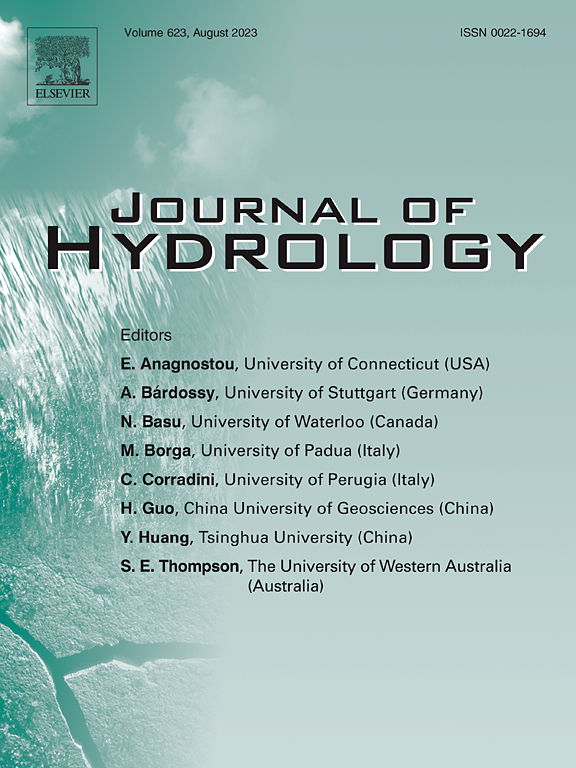Exports of organic matter, phosphorus and nitrogen from Sichuan Basin: A critical region regulating water quality of the Upper Yangtze River, China
IF 6.3
1区 地球科学
Q1 ENGINEERING, CIVIL
引用次数: 0
Abstract
The Chinese Yangtze River is a crucial nexus for nutrient cycling between the Qinghai-Tibet Plateau and the East China Sea, but it faces significant water quality challenges due to enhanced nutrient inputs from its sub-basins. The nutrient exports from the Sichuan Basin, a geographical region with intense human activities in southwest China, are foreseen to have significant impacts on the water quality of the Upper Yangtze River. To investigate the nutrient exports from the Sichuan Basin and their effects, we analysed daily data on Total Nitrogen (TN), Total Phosphorus (TP), and Chemical Oxygen Demand (COD, proxy representing organic matter) collected from 58 monitoring stations on rivers across the Sichuan Basin during 2021–2023. The results indicated that the Sichuan Basin contributed approximately 50% of the increased TN, TP, and COD in the Upper Yangtze River. The Minjiang and Qujiang Rivers rank highest in the Sichuan Basin for TN, TP exports and COD exports, respectively. Hotspots of TN and TP levels were primarily concentrated in the the western basin, while COD hotspots were mainly located in the eastern basin. The spatial analysis identified urbanization and agricultural activities as the primary drivers of nutrient distribution patterns in the Sichuan Basin. These findings underscore the need for targeted policies and strategies to enhance the controlling TN and TP losses from urban and farming areas in the rainy seasons within the catchments of the Minjiang and Tuojiang Rivers is critical for achieving sustainable water quality improvements in the Upper Yangtze River. Moving forward, the implementation of integrated pollution management strategies, supported by real-time monitoring and machine learning-based predictive modeling, is imperative in the Sichuan Basin to address the challenges of water quality deterioration driven by climate change.
四川盆地有机质、磷、氮输出:长江上游水质调节的关键区域
中国长江是青藏高原和东海之间养分循环的重要纽带,但由于其子流域的养分输入增加,长江面临着重大的水质挑战。四川盆地是中国西南地区人类活动最密集的地理区域,其养分输出对长江上游水质有重要影响。为了探讨四川盆地的养分输出及其影响,本文分析了四川盆地58个河流监测站2021-2023年的总氮(TN)、总磷(TP)和化学需氧量(COD,代表有机质)日数据。结果表明,四川盆地贡献了长江上游近50%的总氮、总磷和总COD增加量。岷江和曲江分别是四川盆地TN、TP和COD出口量最大的河流。总氮和总磷水平热点主要集中在盆地西部,而COD热点主要集中在盆地东部。空间分析表明,城市化和农业活动是四川盆地养分分布格局的主要驱动因素。这些研究结果强调,需要有针对性的政策和策略来加强控制岷江和沱江流域雨季城市和农业地区的总氮和总磷损失,这对于实现长江上游水质的可持续改善至关重要。展望未来,在实时监测和基于机器学习的预测建模的支持下,实施综合污染管理战略在四川盆地势在必行,以应对气候变化导致的水质恶化的挑战。
本文章由计算机程序翻译,如有差异,请以英文原文为准。
求助全文
约1分钟内获得全文
求助全文
来源期刊

Journal of Hydrology
地学-地球科学综合
CiteScore
11.00
自引率
12.50%
发文量
1309
审稿时长
7.5 months
期刊介绍:
The Journal of Hydrology publishes original research papers and comprehensive reviews in all the subfields of the hydrological sciences including water based management and policy issues that impact on economics and society. These comprise, but are not limited to the physical, chemical, biogeochemical, stochastic and systems aspects of surface and groundwater hydrology, hydrometeorology and hydrogeology. Relevant topics incorporating the insights and methodologies of disciplines such as climatology, water resource systems, hydraulics, agrohydrology, geomorphology, soil science, instrumentation and remote sensing, civil and environmental engineering are included. Social science perspectives on hydrological problems such as resource and ecological economics, environmental sociology, psychology and behavioural science, management and policy analysis are also invited. Multi-and interdisciplinary analyses of hydrological problems are within scope. The science published in the Journal of Hydrology is relevant to catchment scales rather than exclusively to a local scale or site.
 求助内容:
求助内容: 应助结果提醒方式:
应助结果提醒方式:


